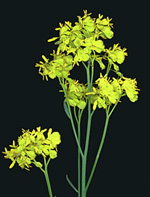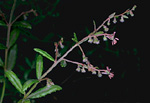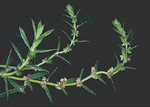 |
A small but cosmopolitan family, most species of Haloragaceae occur in southern temperate parts of Australia in open, sunny communities or open forests. One genus (Myriophyllum) is an aquatic, in shallow, sometimes impermanent water.
Characteristic features of the family Haloragaceae in Australia include: - herbs or subshrubs with simple to much-dissected, opposite or alternate, usually toothed leaves.
- flowers inconspicuous, unisexual or bisexual, usually with 4 valvate, greenish or reddish sepals and the same number of (often similar) petals
- stamens 4 or 8
- ovary inferior with 4 fused carpels, usually winged or ribbed, and in some species brightly coloured when mature.
Description
Evergreen shrubs, or annual or biennial terrestrial herbs, or aquatic herbs, free-floating at or below the water surface or rooted in the substrate with their leaves submerged or emergent. Perennating by rhizomes or taproots. Vegetative reproduction by rhizomes or stolons. Leaves present or leaves rarely ±absent. Stem internodes solid or spongy or pithy, terete or angular. Internal secretions not obvious. Plants glabrous or with simple, non-glandular (very rarely apparently glandular), unicellular or uniseriate hairs. Leaves well developed or rarely much reduced (i.e. to scales, etc.), alternate and spiral, opposite, or in whorls of 3–6, cauline if herbs, petiolate, subsessile or sessile. Stipules absent. Lamina simple or apparently pinnate, symmetric, pinnatifid or pinnatisect; lamina/lobes filiform, acicular, subulate, linear, lanceolate, ovate, elliptic, oblanceolate, obovate or oblong; base cuneate, rounded or cordate; margins entire, crenate, dentate or serrate, ±flat; venation one veined, or pinnate, with the midrib conspicuous or inconspicuous, and the tertiary venation not reticulate; surfaces not punctate; herbaceous, leathery or succulent. Male and female flowers occurring on the same plant or on separate plants, or bisexual flowers occurring with male and female flowers together, or with either male or flower flowers occurring with bisexual flowers on the same plant, or all the flowers bisexual. Inflorescences terminal or axillary, consisting of spikes, racemes, panicles, cymes, corymbs or solitary flowers. Bracts and bracteoles present. Pollination by wind. Flowers odourless; sessile or stalked. Floral disc absent; nectaries absent. Perianth regular, of 2 dissimilar whorls, of 1 whorl only or all whorls ±similar or vestigial or absent. Calyx segments free, with 2–4 sepals, valvate or open in bud, herbaceous or papery; base with wings or other appendages or without spurs, pouches or wings. Corolla segments free, with 2–4 petals, sometimes absent especially in female flowers, alternating with the calyx segments, valvate in bud, usually hooded, cream, yellow, red, magenta, purple or green, without contrasting markings, or streaked, membranous or papery; claws present or absent; lobes ±entire. Fertile stamens 2–4, 6 or 8, both opposite to and alternating with the sepals, free of the corolla, free of the ovary and style, distinct from each other, all ±equal. Anthers basifixed, not versatile, opening sideways by longitudinal slits, 4-celled; appendages absent or apical. Ovary inferior. Carpels (1–) 3–4, fused; ovary with 1–4 locules. Style terminal on each carpel, sometimes appearing as one and branching from base. Ovules 1 (–2) per locule, sessile; placentation apical. Fruit a dry, indehiscent nut or a schizocarp forming cocci; the perianth on the maturing fruit deciduous or dry and persistent. Disseminule macro-surface featureless, winged or rarely with spines; micro-surface ±smooth, spinulose, papillate, tuberculate or rugose, white, cream, yellow, red, brown, grey or black, glossy or dull. Seeds 1–4 per fruit. Aril absent. Cotyledons 2. Embryo straight.
(Note: this description has been generated from the coded data compiled for the key. Any errors in the key data will be reflected in the descriptions.)
A treatment of the family Haloragaceae has been published in:
Flora of Australia 18: 5-85.
Australian genera of Haloragaceae (as recognised for the Flora of Australia)
† = some species native, others introduced
Glischrocaryon
Gonocarpus
Haloragis
Haloragodendron
Meziella
†Myriophyllum

|
  |

Glischrocaryon aureum (flowers)
Photo: M.Fagg © ANBG

Glischrocaryon behrii (flowers)
Photo: R.Hotchkiss © ANBG

Gonocarpus teucrioides (flowers)
Photo: M.Fagg © M.Fagg

Haloragis aspera (flowers)
Photo: M.Fagg © M.Fagg

|
 |
|